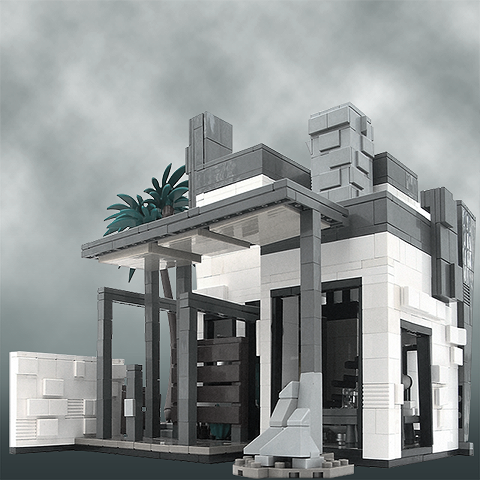12 Useful Building Engineering Lessons from Lego

A number of recent architectural programs on the BBC (e.g ’The Brits who Built the Modern World’) have cited the influence and inspiration Lego has had on many of our leading architects. However, some of those same architects criticised the move in emphasis from free-form bricks to planned boxed sets. As a child - we had a large wooden Lego box of primary-coloured chunky pieces - nowhere near the range or flexibility of the current 250+ shapes in 40+ colours (near enough 1600 different elements now - obviously not all shapes in all colours). In my youth therefore, Lego was as boxy as a 70’s Volvo, and most buildings we created looked like some kind of square warehouse or storage / industrial facility.
Our British architect friends are forgetting that you can still buy the old-fashioned free-form building sets - as well as any combination of bricks / pieces from the ’Pick a Brick’ facility of the Lego Shop; adults can even purchase the Lego Architecture Studio - all in white - to plan and conceive the most pristine of modern buildings.
I contend though that it is in building the various boxed set buildings, that you learn the most about the structural integrity of buildings. And only once you have completed a few instructed builds, are you in a position to truly build successfully on a free-form scale. I love building the larger Lego sets mostly because of the insights into the ingenious design process of the set’s designers. Lego is a great example of an applied art, where planned structures and objects need to be streamlined and honed - so that they can be built from the existing 254 shaped elements.
When I build a Lego set, I experience a tiny part of the creative development process into how a certain section came to be devised to overcome the limitations of Lego, as well as make the most of its inherent attributes. When you build complex sets you learn about a number of different key considerations which can be applied equally to real-world building engineering.
Here are my top 12:
Lamination
Often when constructing a modular Lego element, you can feel that the structure is quite fragile really until you finally apply the top layer of ’fixing-bricks’ usually in the form of thin slivers (Lego plates + tiles) - these lock the components together and make the structure robust. In lots of modern manufacturing we use different layers - sandwiches or bonded wafers of materials which produce the inherent strength of lamination. Lots of high quality desk-tops are made from several bonded veneers - using the lamination process - to make the resulting furniture many times more rigid / stronger / durable than any single element could be. The Lego Death Star’s floors are all made up of 3-layered laminated sandwiches - and you can feel the strength and rigidity increasing as you slot on each new layer.
Angle Brackets / L-Shaped Bricks
I’m quite surprised that the UK building industry has not manufactured / adopted the 90° / right angled ’L’ shaped brick. In constructing most Lego buildings these blocks are essential components in giving the overall structure massive strength and rigidity. The effect is the same as Angle Brackets - which are more commonly available in the building trade. Lego’s Robie House’s many corners are rigidly locked into position with a very large number of ’L’ shaped bricks (Corner Plates).
Offset Bricklaying
You cannot build a wall by applying exactly the same size of bricks directly on top of each other - this is exactly the same principle as in real-world bricklaying where you have a circa 50% overlap on every brick. Thus with Lego builds - alternating rows of bricks have a different arrangement of pieces - to give more structural integrity. I would love to see real world buildings made out of some larger scale alloy Lego bricks (obviously insulated, and with some clever integrated system of ducting for electricity, heating and water).
Modularisation
The Scandinavians are the masters of modularisation - having given us both Lego and IKEA. Every Lego build is made up of numerous individual steps where you build up a component or sub-structure and then bolt it onto the whole. This is very much how modern buildings are engineered - with smaller assemblies and components created off-site and then simply slotted onto the main building.
Frameworks
Like the steel lattice-works which enabled the skyscrapers, many a Lego building starts with you laying out the outer perimeter framework before you start bolting on the various modules, components and elements which fill in the structure. Lego buildings do differ from real-world buildings in that they are largely built-up level-by-level including interiors, whereas real-world buildings are usually constructed as hollow shells, with interiors completed later. The Paris Pompidou Centre is a marvellous Lego-like but essentially inside-out building where all the utilities, stairs, escalators and lifts etc. are on the outside / perimeter of the building (buffalo gals style!).
Curtain Walls
As innovated by our leading British Architects in the 70’s - Curtain Wall Architecture was a solution to very tight deadlines and even tighter budgets. This evolved from the steel frameworks and allowed building engineers to manufacture components off-site and easily bolt them onto the framework - leading to a lower cost, blistering speed of deployment with the added benefit of more flexibility. Several Lego buildings - like the Tokyo Imperial Hotel apply this mechanic in how some of the window elements are slotted in en-masse. Curtain Walls are in essence an entire built-up wall / window panel which is slotted and bolted into position versus building brick by brick, row by row - this modern pre-fabrication is essentially how all large-scale contemporary buildings are made.
Gearing
There’s of course Lego Technic for the more mechanically minded - utilising tubular components with multifarious cogs and ratchets and multi-way adapters / connectors. Much of this though finds its way into other Lego building sets - where you will find several Lego Technic pieces utilised to carry out a higher level mechanical function. If you need a moving or rotating part of the structure or you need to connect pieces in an unusual manner - you will normally find some sub-assembly of Lego Tehcnic pieces to serve that purpose.
Tolerances / Clearances
In completing a Lego building, however clear the instructions are, you do occasionally loose focus and make mistakes. That so many mistakes become immediately apparent is an inherent side-benefit of the building process - where you learn how elements best click together to produce the optimal fit and suit the best purpose. You almost pick it up subconsciously - and even when you don’t you soon spot how the building is no longer fulfilling its ultimate promise as parts seem weaker or more / less flexible than they should be. This is particularly evident with moving parts - where an out-of-place piece usually curtails any movement. An out-of-place can be wrongly places, as well as not simply sufficiently snapped into its final resting place - the more detailed the model; the more refined the tolerances are.
Load-bearing Structures
Back to the heavyweight 8Kg Lego Death Star - it really is a monster in every way, and although parts of it are still fragile, the main parts of the structure (walls and supports) are pretty darn solid. A few Lego sets are unfortunately more fragile than they should be. If you have been using Lego for a while, you begin to think how you can brace and strengthen assemblies (laminate?) to overcome any areas of weakness. You become very aware of which parts of the structure are load-bearing or likely subjected to the most wear-and-tear, and this informs and improves your subsequent builds.
Space Utilisation / Spatial Awareness
The genius of Lego is accomplishing so much within a relatively small form factor. Most Lego buildings - like the recent Simpson House, are crammed with details and features. So much so though, that you start thinking how perhaps this or that area has been poorly conceived as it either has too much space for its function or not enough. Lego tunes your mind into being very spatially aware - so that you start thinking more about living spaces and how you might best accommodate / fit in an extra wardrobe or chair etc. Lego is not just influencing exterior design, but several contemporary interiors are taking on Lego’s modular approach to living - where areas are multi-use and elements can be rotated, stowed away and or switched up and re-purposed for different uses.
Lighting
Those Lego building which have windows - Simpson House and Farnsworth House included, give you an appreciation for lighting and natural daylight - in terms of how you consider and place the many windows around a house’s perimeter. In Iceland we have limited daylight for large parts of the year, which means most houses have enormous windows right around the building. In hotter climates, too much glazing radiates and traps heat, and you tend to go for fewer, smaller windows. You are also aware of outside-looking-in viewpoints, and how exposed the inhabitants of the building become at night-time with interior illumination. Lego helps shape your awareness for the need to regulate and make best use of both natural and artificial light.
Ornamentation / Cladding
One of Lego’s greatest virtues is the ease with which you can plug in an additional connector and bolt on an intricate and shiny exterior. The Tower of Orthanc and Black Gate sets have some wonderful finishing touches à la Curtain Walls (q.v.) - where the shiny exterior walls are prepared separately and then bolted on en-masse. Because of how Lego works, you have unlimited scope in how you can ornament and differentiate the exterior of your buildings - through the careful placement of solid blocks - you can achieve some amazing textured effects which would be very expensive in real life.
Postscript
I’m sure most home owners side with me when I say I would like modern buildings to be more like Lego! By this I mean the ease of adding to or changing the appearance and function of all your living areas. Would you not love it if more things could be plug-and-play? You would not have to call out a plumber to change bathroom fixtures or and electrician to fit a new power-point - you would just slot one in where required. Admittedly some larger scale industrial buildings have significant elements of these, but very few domestic houses do. I patiently await the development of the ultimate modular house - where I could shape and evolve every aspect of my living environment at will - utilising simple bolt-on modules ...

Did you find this content useful?
Thank you for your input
Thank you for your feedback
Upcoming and Former Events
PPA Independent Publisher Conference and Awards 2023
Affino Innovation Briefing 2023
Press Gazette Future of Media Technology Conference 2023
PPA Awards 2023
Meetings:
Skype and Zoom
Registered Office:
55 Bathurst Mews
London, UK
W2 2SB
© Affino 2024





















